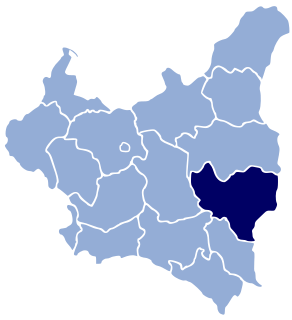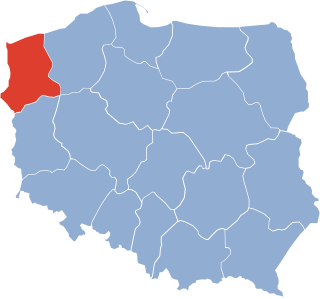
Volhynian Voivodeship was a unit of administrative division and local government in the Grand Duchy of Lithuania from 1566 until 1569 and of the Polish Crown within the Polish–Lithuanian Commonwealth from the 1569 Union of Lublin until the Third Partition of Poland in 1795. It was part of the Ruthenian lands in the Lesser Poland Province.

Polesie Voivodeship was an administrative unit of interwar Poland (1918–1939), named after the historical region of Polesia. It was created by the Council of Ministers of the Second Polish Republic on February 19, 1921, as a result of peace agreement signed with the Russian and Ukrainian SSRs in Riga. Polesie Voivodeship was the largest province of interwar Poland. It ceased to function in September 1939, following the Nazi-German and Soviet invasion of Poland in accordance with a secret protocol of the Nazi–Soviet Pact of non-aggression.

Wołyń Voivodeship or Volhynian Voivodeship was an administrative region of interwar Poland (1918–1939) with an area of 35,754 km², 22 cities, and provincial capital in Łuck. The voivodeship was divided into 11 districts (powiaty). The area comprised part of the historical region of Volhynia. At the end of World War II, at the insistence of Joseph Stalin and the Soviet Union during the Tehran Conference of 1943, Poland's borders were redrawn by the Allies. The Polish population was forcibly resettled westward; and the Voivodeship territory was incorporated into the Ukrainian SSR of the Soviet Union. Since 1991 it has been divided between the Rivne and Volyn Oblasts of sovereign Ukraine.

Volhynian Governorate was an administrative-territorial unit initially of the Russian Empire, created at the end of 1796 after the Third Partition of Poland from the territory of the short-lived Volhynian Vice-royalty and Wołyń Voivodeship.

Białystok Voivodeship was a unit of administrative division and local government in Poland from 1944 to 1975, when its purview was separated into eastern Suwałki Voivodeship, Łomża Voivodeship and Białystok Voivodeship (1975–1998). Its capital city was Białystok. The establishment of Podlaskie Voivodeship in 1999 was essentially a reunion of the areas of Białystok Voivodeship (1945–1975).
According to the 1935 Polish Constitution, the country was divided into 104 electoral districts, and the Sejm consisted of 208 members. The districts were described in a July 8, 1935, edition of the Journal of Laws of the Republic of Poland, and were:

Civil Administration of the Eastern Lands was a civil authority of the territories controlled by Second Polish Republic but not incorporated into the state itself, that was formed during the Polish–Soviet War in 1919 and existed until 1920. It was formed on 19 February 1919 from the territories taken by Poland during the war, that were previously occupied by the Russian SFSR. In the summer of 1920, forces of Russian SFSR had conquered the area. After part of the area was reconquered by Poland, the administration was formally disestablished on 9 September 1920, and replaced by the Provisional Administration of Front-line and Phase Territories.

Wołyń District League was a regional association football championship in the Wołyń Voivodeship, Poland in 1930–1939.

Civil Administration of the Lands of Volhynia and Podolian Front, also known as Commissariat of the Lands and Podolian Front was a civil authority of the territories controlled by Second Polish Republic but not incorporated into the state itself, that was formed during the Polish–Soviet War in 1920. It was formed on 17 January 1920 from the Civil Administration of the Eastern Lands and included Volhynian District and the surrounding area. In the summer of 1920, forces of Russian SFSR had conquered the area. After part of the area was reconquered by Poland, the administration was formally disestablished on 9 September 1920, and replaced by the Provisional Administration of Front-line and Phase Territories.

Provisional Administration of the Front-line and Phase Territories was a civil authority of the territories controlled by Second Polish Republic but not incorporated into the state itself, that was formed during the Polish–Soviet War in 1920. It was formed on 9 September 1920 replacing Civil Administration of the Eastern Lands and Civil Administration of the Lands of Volhynia and Podolian Front. On 20 December 1920, it was deistablished and its terretories incorporated into Poland.
Chief of District was a public official in Second Polish Republic with the power to govern the districts. He was a representative of the Council of Ministers, responsible for the implementation of the laws as well as superior to local administration offices.

Nowogródek District was a district of Second Polish Republic from 1920 to 1921. Its capital was Novogrudok. It was formed on 20 December 1920 from the parts Wilno, Brześć, Mińsk Districts of the freshly disestablished Provisional Administration of Front-line and Phase Territories. On 19 February 1921 it was reformed into Nowogródek Voivodeship.
The Administration of Volhynian Counties was a provisional administrative division of the Civil Administration of the Eastern Lands controlled by the Second Polish Republic. It was established on 7 June 1919 and was incorporated into Volhynian District on 9 September 1919. Its capital was Kovel and it consisted of the counties of Kowel, Łuck and Włodzimierz.

Polesian District was a district of Second Polish Republic from 1920 to 1921. Its capital was Pinsk. It was formed on 20 December 1920 from the parts of Brześć and Volhynian Districts of the freshly disestablished Provisional Administration of Front-line and Phase Territories. On 19 February 1921 it was reformed into Polesie Voivodeship.

Volhynian District was a district of the Civil Administration of the Eastern Lands from September 1919 to January 1920, Civil Administration of the Lands of Volhynia and Podolian Front from January 1920 to September 1920 and Provisional Administration of Front-line and Phase Territories from September 1920 to December 1920, all of which were under the control of the Second Polish Republic. Its seat was located in Lutsk, and before that, its provisional seat was in Kovel.

Podolian District was a district of the Civil Administration of the Lands of Volhynia and Podolian Front that was under the control of Second Polish Republic. It existed from 17 January 1920 until summer 1920 when it was conquered by the Ukrainian SSR during the Polish–Soviet War. Its seat was located in Kamianets-Podilskyi.

Brześć District was a district of the Civil Administration of the Eastern Lands from June 1919 to September 1920, and Provisional Administration of Front-line and Phase Territories from September 1920 to December 1920, all of which were under the control of the Second Polish Republic. Its seat was located in Brest-Litovsk. In December 1919, it had an area of 57,758 km², and was inhabited by 1,121,978 people.

Mińsk District was a district of the Civil Administration of the Eastern Lands from September 1919 to September 1920, and Provisional Administration of Front-line and Phase Territories from September 1920 to December 1920, all of which were under the control of the Second Polish Republic. Its seat was located in Minsk. In December 1919, it had an area of 35,947 km², and was inhabited by 1 091 138 people.

Wilno District was a district of the Civil Administration of the Eastern Lands from June 1919 to September 1920, and Provisional Administration of Front-line and Phase Territories from September 1920 to December 1920, all of which were under the control of the Second Polish Republic. Its seat was located in Vilnius. In December 1919, it had an area of 48,466 km², and was inhabited by 1,633,504 people.

The Szczecin Voivodeship was a voivodeship (province) with capital in Szczecin, that was centered on the Farther Pomerania. It existed from 1946 to 1975. Until 19 February 1947 it under the administration of Provisional Government of National Unity, which then was replaced by the Polish People's Republic. It was established on 28 June 1946, when it replaced the District of the Western Pomerania. On 6 July 1950, its eastern half was incorporated into then-established Koszalin Voivodeship, and the voivodeship ceased to exist on 31 May 1975, when it was replaced by then-established Szczecin and Gorzów Voivodeships.
















